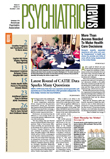A new screening tool for dementia developed by geriatric experts at St. Louis University School of Medicine appears to be better at identifying mild cognitive problems in elderly patients, compared with the most commonly used screening tool.
Identifying mild cognitive changes at an earlier point in the progression of a patient's cognitive decline could allow clinicians to initiate effective treatments earlier, potentially altering the progression of the disease.
Since its development in 1975, the Mini-Mental State Examination (MMSE) has been routinely administered by physicians to patients who they suspect may have Alzheimer's disease or another dementia. While the MMSE is quick and easy to administer and has been validated in many research studies as a sensitive test for moderate to severe cognitive decline, the MMSE does not effectively spot early, mild cognitive changes, according to the geriatric experts at St. Louis Univeristy.
The new screening tool, the St. Louis University Mental Status Examination (SLUMS), was developed to give clinicians a better gauge of early changes that could signal the onset of dementia and indicate to physicians when they should pursue further testing to support or rule out a dementia diagnosis.
A comparison of the SLUMS and the MMSE for detecting dementia and mild cognitive disorders appeared in the November American Journal of Geriatric Psychiatry. The research was funded by St. Louis University School of Medicine and the Department of Veterans Affairs.
“[The] early detection of mild neurocognitive disorder by the SLUMS offers the opportunity for clinicians to begin early treatment, as it becomes available,” syed Tariq, M.D., an associate professor of geriatric medicine at St. Louis University and the lead author of the report, said in a press release.
John Morley, M.D., director of the Division of Geriatric Medicine at St. Louis University and the principal investigator on the research, created the SLUMS specifically to detect early cognitive problems in patients with higher levels of education.
“The Mini-Mental Status Examination has limitations, especially with regard to its use in more educated patients and as a screen for mild neurocognitive disorder,” Tariq said.
It takes a clinician about seven minutes to administer the SLUMS, which supplements the Mini-Mental Status Examination by asking patients to perform tasks such as doing simple math computations, naming animals, recalling facts, and drawing the hands on a clock.
To determine validity and reliability of the SLUMS, the St. Louis University team prospectively recruited 705 male patients aged 60 or older from January 2003 through September 2003 at the Geriatric Research Education and Clinical Center of the Veterans' Affairs Medical Center in St. Louis. Recruiting was done during routine clinic visits in which study participants were evaluated for signs of cognitive impairment or dementia. With some of the patients, a full history was also obtained from corroborating sources (family members or caregivers), if available.
In addition, for all patients a complete physical and mental status examination was performed and laboratory findings reviewed. The investigators used DSM-IV criteria to make a diagnosis of mild neurocognitive disorder or dementia. The investigators then completed the MMSE and SLUMS. Those who did not qualify by any of the DSM-IV criteria were considered to have normal cognition or no cognitive problems, without considering the scores of MMSE or SLUMS.
The researchers found that while both tools reliably detected dementia, only the SLUMS recognized a subset of patients having mild cognitive problems.
“SLUMS has the advantage in that it can help the clinician identify patients with mild neurocognitive disorder on the initial visit compared with the MMSE, which requires follow-up screening,” Tariq explained.
The researchers cautioned that neither the SLUMS nor the MMSE screening tools substitute for clinical assessment and fuller neuropsychological testing to diagnose cognitive problems and dementia.
The SLUMS is currently used at many VA hospitals, Tariq said, and is available online.
